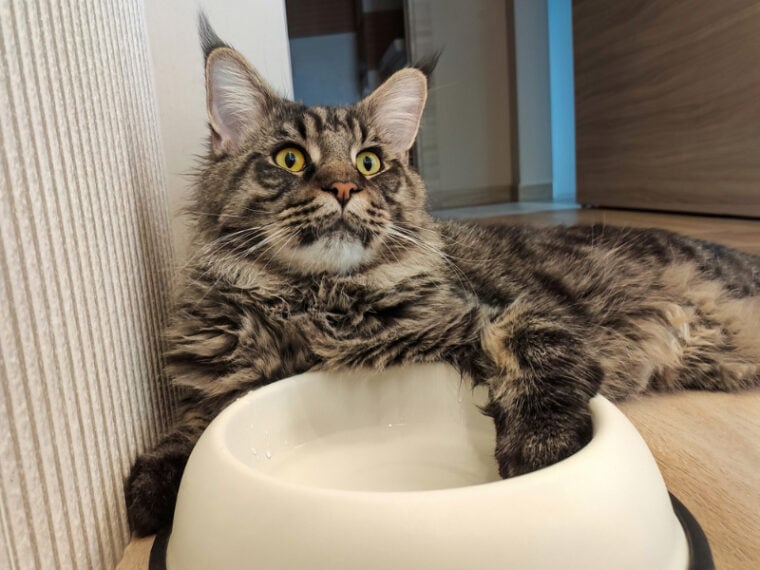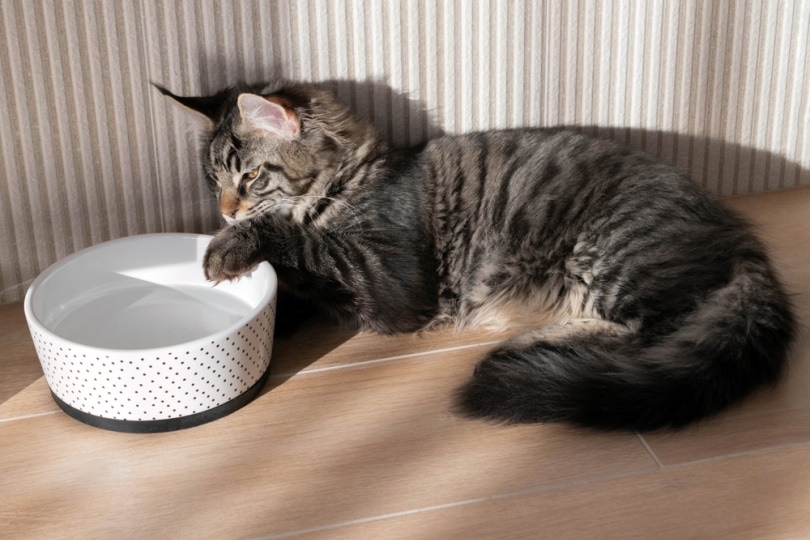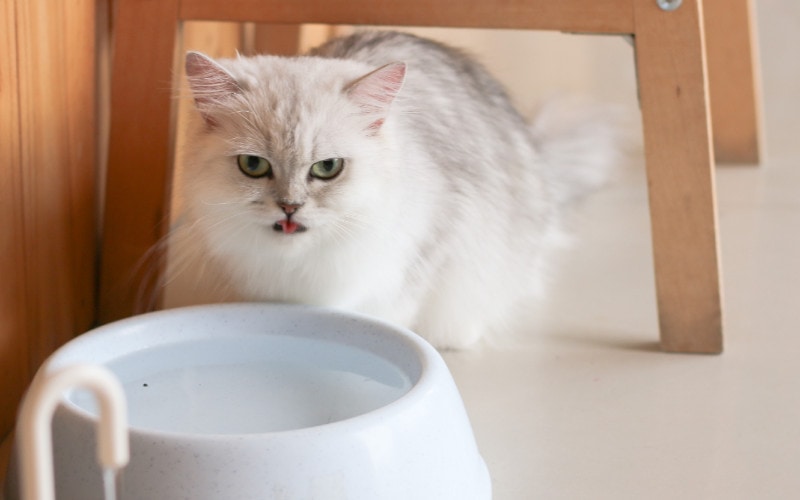
For animals that are well-known for disliking water, a surprising number of cats spend a great deal of time dipping their paws into their water dish. Sometimes, this behavior can be endearing, especially when your cat carefully licks their paw clean. However, it can also lead to puddles that you need to clean up when your playful feline flicks the water all over the place or knocks over their bowl.
There are many reasons that a cat may put a paw in their water. Fortunately, there are also a few ways that you can use to get them to stop.
Why Do Cats Put Their Paws in Their Water?

It looks strange, but it’s usually completely normal for cats to dip their paws into their water dish. The reasoning behind the behavior isn’t always simply because they enjoy getting wet, especially if they’re kittens exploring their environment.
There are many reasons that a cat might dip their paw into their water:
The 8 Tips for Keeping Your Cat From Putting Their Paw in Their Water
1. Use a Mat or Absorbent Pad
Placing a mat or absorbent pad underneath your cat’s water dish won’t stop your cat from dipping their paw into their water, but it can at least help you keep the area surrounding the bowl clean and contain any spills.
Figuring out why your cat is putting their paw in their water and then stopping the behavior can take a while. By catching the spills and splashes with a mat first, you’ll find it much easier to clean up.
2. Determine the Cause
Tackling your cat’s habit of putting their paw in their water will take trial and error. You can make your task easier by determining the possible causes first.
If your cat is playing with their water because they’re bored, preventing the behavior might be as simple as giving them more activities to keep them occupied. Play with them more often, or give them a wider variety of toys to explore.
Also, consider environmental factors that might be worrying your cat. If they’re stressed because there’s a new pet or family member in the house, you’ll need to be reassuring but patient. Make sure they have free access to their water in a quiet area that they feel safe in away from potential stressors.

3. Change the Water Bowl
Your cat might be dipping their paw into their water because of the bowl itself. The material that the bowl is made from and how big it is can affect whether cats drink from it or not.
Some cats might even be fussy about the shape of the bowl. Whisker fatigue is used to describe the theory that cats can suffer from sensory overload if their sensitive whiskers are continuously in contact with an object. If a cat has to drink from a narrow, deep bowl this may mean their whiskers are overstimulated from the side of the bowl, making it unpleasant for them to put their heads in and cause them to put their paw in instead. Although not all vets believe this is a cause of stress and it remains an unproven theory, most would agree that cats prefer eating and drinking from a flatter surface.
If you suspect that the water bowl is the issue, it’s worth changing to a new one. Choose a larger, wider, shallow bowl and experiment with different materials. Many cats prefer glass, stainless steel, or ceramic over plastic but do have individual preferences! Stainless steel is the easiest to clean and the most durable, but it can unnerve cats that aren’t used to seeing a reflection. That can convince certain felines to play more too.
4. Place the Bowl in a Quieter Spot
Cats like to feel safe when they eat and drink, so you can’t put their food and water dishes just anywhere in the house. Keep your cat’s water dish away from their food bowl and litter tray, but make sure it’s in a quiet spot. This means avoiding busy routes through the house and choosing a spot that your cat feels safe in.
Also, remember to give your cat space to sit at the water bowl without putting their back to the room. Putting the bowl in a corner might look neat and tidy, but if your cat can’t see what’s going on behind them, it might make them feel wary about drinking, especially if another pet likes to ambush them.

5. Make Sure the Water Is Clean
Some cats put their paws in the water to investigate something floating in it. They can be fussy about cleanliness and might be trying to remove an offending bit of fluff or other debris that could be floating in their bowl. Unfortunately, dipping their paw in their water can make the issue worse by adding even more dirt!
Throughout the day, check the water dish regularly. Giving your cat constant access to fresh water means keeping the bowl topped up and ensuring that the water is clean.
If you spot your cat splashing in their bowl, check to make sure there isn’t something floating in it. It might be a toy that your cat deliberately dropped in there to play with, or it might be dirt or other debris.
6. Get a Second Water Bowl
If you have more than one pet, your cat might be putting their paw in the water because they don’t want to risk getting pounced on. Lowering their head into a deep bowl to take a drink can make them feel vulnerable. If they feel threatened, they may be more likely to lick the water off their paw instead.
Although getting a second water bowl might sound like more puddles to clean up—and that might be the case if your young kitten is feeling playful—it can also help reduce tension around the water dish. In households with more than one cat, the general rule of thumb is the ‘plus one’ rule. This means that for each cat you should provide one water bowl plus a spare. This also applies to other resources such as food bowls, litter trays, and sleeping areas. This reduces competition and conflict between cats.

7. Switch to a Water Fountain
For many cats, drinking still water goes against their instincts, and they do their best to avoid it. They might splash the water to try to make it more appealing. Some cats also dislike how the water depth in their bowl changes the more they drink and when you fill it up. You might find that they dip their paw in to test how deep the water is before drinking.
Water fountains can help with this. It’ll provide your cat with a running water source, and the fountains usually have a tray above the reservoir that holds a shallow pool of water. While fountains aren’t splashproof and some cats will still bat at the water, it can help encourage them to drink more rather than splash it around. The consistent water level can help reassure cats with vision loss too.
8. Rule Out Medical Issues
Health concerns are a less common cause of your cat dipping their paw in their water. However, if they are showing sudden changes in behavior and you’ve tried everything else, you’ll have to consider that there might be an underlying medical reason and you should take them to your vet for a checkover.
Vision loss is one possible cause. While some causes of vision loss are unavoidable, others are treatable. Early treatment can even help prevent permanent blindness in some cases, so pay close attention to your cat’s behavior.
Older cats may also suffer from joint and mobility issues which may affect how they drink water and conditions such as diabetes and kidney disease will increase a cat’s thirst. If your feline friend is showing any signs of vision loss or ill health then go to your veterinarian as soon as possible.
Conclusion
Cats have many habits that we might find odd. Dipping their paw into their water bowl is one that we can find both endearing and annoying. With all the puddles that we have to mop up sometimes, it’s a relief to know that there are ways to help reduce the behavior.
Your curious kitty is likely just being playful and investigating the water, but underlying stress, boredom, and health concerns can also be causes of the behavior. We hope that his guide has helped you determine why your cat is playing with their water and steps you can take to help prevent it.
Featured Image Credit: Pickless, Shutterstock








